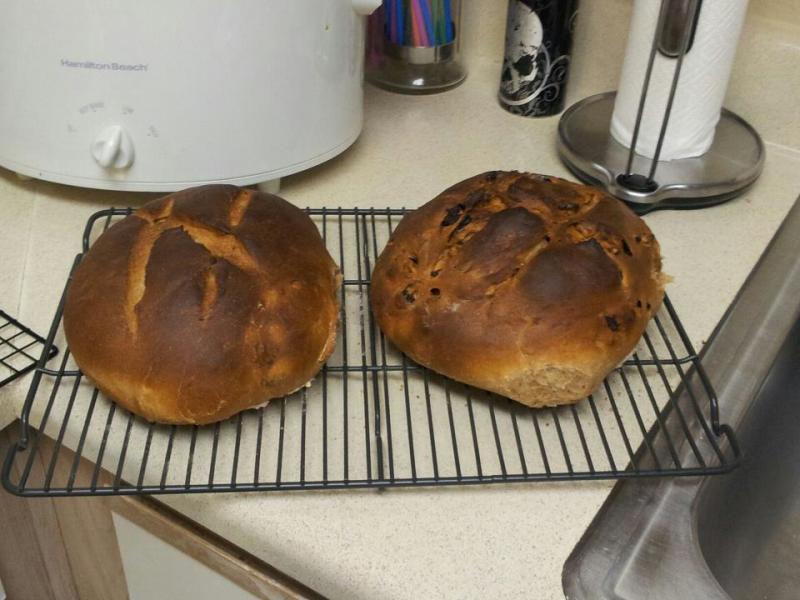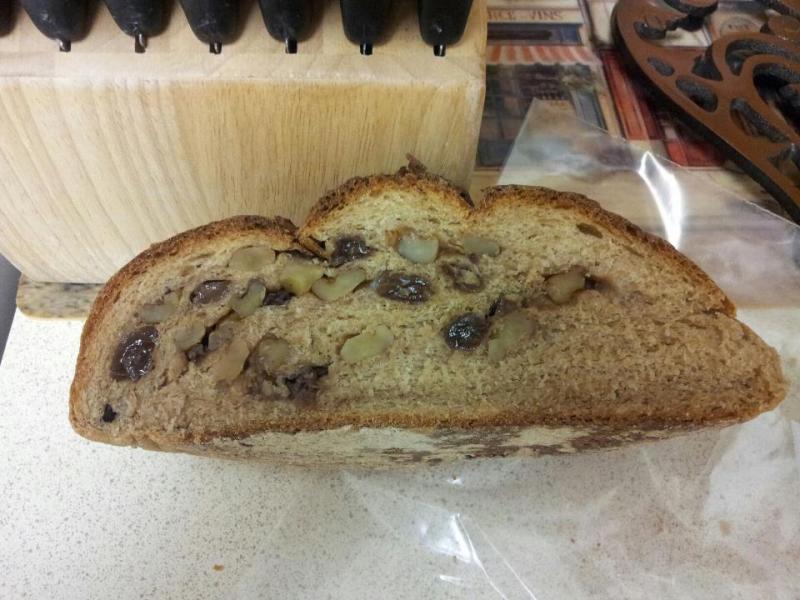In continuing my mission to bake my way through The Bread Bible, I had the opportunity to try the recipe for Whole Wheat Walnut Raisin Bread. I was a bit worried it would be a bit advanced for my skill level, but I was baking it for my dad, who needed to transition to whole wheat bread to aid in his recovery from intestinal surgery.
The first thing that made me nervous was plumping the raisins, something I had never done before. But, a quick Google search led me to completely cover them in boiling water and set the timer for an hour as I worked on the dough. I drained them in a collander and then on a papertowel, trying to get them as dry as possible, but now I'm wondering if one shouldn't keep them a little moist so the finished loaf doesn't dry out....? At any rate, I hand mixed them with the walnuts and set aside.
I found the dough to be pretty easy to knead and not nearly as nubby as I thought it would be. However, it did seem to be rising very slowly.
Since the formulae called for a two- to two-and-a-half rise to double in bulk as opposed to the usual hour, I assumed this was normal. At any rate, the dough eventually reached the doubled point, a little over two hours after being set to rise.
This is where some mild difficulty began. The first fill-and-roll went fine.
The second, not so much.
I had a hard time keeping all the walnut pieces and raisins in the dough, though eventually I got there.
I then cut the dough into three pieces, but (and I’ve already tried this recipe again), the middle piece inevitably ends up with far more filling. And, much to my disappointment and frustration, the dough began to tear over the filling in the middle boule:
I wasn’t sure if this was ok or not—on the one hand, I’d certainly seen boules like that in stores and whatnot, but on the other hand, the other boules felt more sturdy. Still, after about forty minutes of futzing around with it, I decided to just let the three boules sit for their second rising and learn by doing when the time came.
Scoring them also proved to be a bit challenging.

When they did come out of the oven, they came out really, really dark. I thought they were burnt, but they ended up tasting ok.

The second time I tried this formulae, I moved the oven rack (on which I have a square stone) to the second-to-the-bottom place, and that seems to have solved the problem. I’m wondering if I shouldn’t leave it there for my other loaves. That being said, sure enough the raisins that were poking out of the middle were burnt and fell off.
Fortunately, the rest of the filling stayed within the loaf, even after slicing. Since this was my first time baking a yeast bread with filling, I counted this as a success.

I was, however, concerned about a small moist streak you can see on the bottom right-hand side. It didn't effect the taste any, and the texture wasn't noticably different, but all the same inconsistency worried me.
- Shutzie27's Blog
- Log in or register to post comments
I have never made this loaf before, but I do know from experience that it is difficult to evenly distribute inclusions like raisins and nuts into dough. You can't put them in at the beginning of the kneading process because they will hamper gluten development (or will be flying all over the kitchen if you are hand kneading) and when you do add them at the end, they are all the more difficult to incorporate because now the gluten is developed and is offering them resistance. Stretch and folds during the bulk ferment help a lot to redistribute inclusions because the gluten is relaxed and provides less resistance. Judging from your dough in the bowl pic and your crumb pic, it looks like your dough could have done with more gluten development. What flour were you using?
Syd
Yes, by 'bulk ferment' I mean the first rise. So you would want to give it at least two (maybe three) stretch and folds during the bulk ferment. If you are unsure, check out this video on how to handle dough during the bulk ferment. Are you using the Bread Bible by Rose Levy Beranbaum? Are you referring to the Raisin Pecan Bread on p.404?
If you are using 100% whole wheat, expect it to be quite a bit denser than an all-white loaf. Why don't you try using a 50/50 mix of bread flour and whole wheat. Make a sponge out of the whole wheat portion of the flour before you add the bread flour. First develop the gluten by kneading for, at least, five minutes before adding the raisins and walnuts. Then do some folding of the dough during the first rise to strengthen the gluten.
Hope this helps,
Syd
King Arthur all purpose should be fine. Google 'folding dough' and you should come up with a few videos that demonstrate the same technique. The Milawa Factory one is great, too.
Syd
You're welcome Shutzie. It isn't quite the same as punching down however the intention is the same. It is done to expel some of the CO2 and also to strengthen the gluten. It also has the added advantage of redistributing the temperature of the dough by folding the (colder) outer dough inwards and the (warmer) inner dough outwards. It is more gentle than 'punching down' and will lead to a lighter, airier loaf. You don't want to destroy all those gas pockets. Watch this video for some explanation behind the technique.
Syd
the way I like it. The crust ends up the way it does when the middle of teh bread gets done. Some vital gluten may have helped the rising. It sure looks tasty.